Your feedback is important to us
Please provide any feedback you have. Thank you!
Thank you!
Your feedback has been submitted.
- Partnership for Assessment of Readiness for College and Careers
Please provide any feedback you have. Thank you!
Your feedback has been submitted.

See what skills are tested, understand your child's scores, and get ideas for how you can help at home.
The Reading Literature standard refers to reading fiction, plays, and poetry. Through literature children learn about relationships, emotions, and human experiences. In fourth grade, kids should be reading increasingly challenging texts, such as The Black Stallion, and poems, such as Shel Silverstein’s Whatif.
As students discuss the poems, drama, or prose they read, they should be able to point to several examples in the text (also called evidence) to back up their summaries and conclusions. Kids learn to use details from the text to describe a story’s setting, events, or characters. For example, in Sarah, Plain and Tall, when the narrator looks at the long dirt road that crawled across the plains, remembering the morning that Mama had died, cruel and sunny, a student might point to the words cruel and sunny as evidence of the narrator’s pain about her mother’s death.
Watch how these fourth graders show their understanding of a text.

They are beginning to understand the point of view of a narrator (first person versus third person) and see how these perspectives are different.
Fourth graders should also be able to describe the differences in how poems, plays, and prose are organized. Poems, for example, group ideas into lines and stanzas while plays tell stories through dialogue and events.
Pick stories and plays your child is interested in, whether they’re about superheroes or historical figures. If a book is hard for your child to read, it’s perfectly fine to take turns reading aloud. Even if you only have time to read a short passage together every day, this will help develop the reading skills your child needs.
Here are some questions to get your child thinking. (Remember to ask Why? and How do you know?)
Through fiction children learn about relationships, emotions, and human experiences. If your child struggles to make these connections, ask her teacher for ways you might help her link her own experiences with the stories she reads.
The Reading Information standard assesses kids’ ability to read all kinds of nonfiction, or informational texts. Kids are being asked to read more nonfiction nowadays because educators have seen that many kids are graduating from high school without the ability to read complex informational texts and it’s hurting them in college and their careers. In fourth grade, kids should be reading lots of nonfiction articles, books, tables, and maps. When students summarize the main idea from information presented, they should be able to give several examples from the text (also called evidence).
Kids also begin to make sense of information presented in maps, timelines, charts, and multimedia presentations about history or science topics. They explain how an author uses certain facts to support a particular idea.
When fourth graders read about history and science they should point to evidence from the text to explain what happened. For example, if asked how we know so much about Springer, a lone orca swimming in Puget Sound described in an article, students might point to how scientists were able to track her movements because they had first captured her in order to help treat a skin rash.
Students should also be able to find similarities and differences from two different sources on the same topic.
Watch how fourth graders are able to build knowledge by reading informational texts.

Let your child pick nonfiction books or articles she’s interested in (biographies, animals, or ancient civilizations). If she struggles to read a text alone, take turns reading it aloud and then talk about it.
Reading requires a combination of many skills: decoding, fluency, reading with expression, and comprehension. Ask your child’s teacher which of these skills are strongest for your child, and which areas need support. Then ask for the best ways you can help.
As fourth graders read both fiction and nonfiction texts, they come across words known as academic vocabulary. These words are used often, in many subjects, but they can be hard to define. Examples include essential, result, or passage. They also encounter content-specific words, which are used when studying a specific subject. For example, metamorphosis is a word your child would most likely encounter in science class.
Students should use three key strategies to figure out the meanings of these words:
Watch how a teacher guides a fourth grader through the process of figuring out new words.

At this age, kids are shifting from literal to abstract thinking. A literal thinker sees the Statue of Liberty as a lady holding a torch, but an abstract thinker recognizes that the statue represents freedom. This is important in fourth grade because as students read they encounter figurative language, such as idioms and expressions that are not literal. (Example: That’s a piece of cake!)
Note that figurative language can be especially challenging for students whose first language isn’t English because they must first learn and understand the literal meaning before interpreting the symbolism. (Imagine trying to understand He needs to get his ducks in a row if you were learning English!)
New words can get in the way of your child’s understanding. If your child pauses or stumbles on a word, he may not know its meaning. When your child comes across a word he doesn’t know, try this:
It’s important for fourth graders to build their academic vocabulary. General academic vocabulary includes precise words (for example, argued, exclaimed, or described instead of said). Check out this list for more academic vocabulary words to use with your fourth grader. Sign up for GreatWords, our free vocabulary-boosting text message program, to get daily text messages with 4th grade academic vocabulary words. To get started, text WORDS to 88769. (See terms and conditions.)
To increase your fourth grader’s academic vocabulary, introduce a new word every day. Tell your child the meaning of the new word, and have him think of another word or phrase that means close to the same thing. For instance, prefer means the same as would rather. Next, make up a sentence using the word. I prefer going for a walk instead of running today. For fun, help your child start a daily word journal. In a notebook or journal, have your child write the word and create his own sentence using the new word or draw a picture to illustrate the word.
Kids also need to be steadily growing their knowledge about the world with every new article, story, and website they read. A strong vocabulary is a huge predictor of academic success because it helps children understand what they read and lets them express their ideas. Ask your child’s teacher what you can do at home to help expand his word knowledge.
Fourth graders should be able to write to tell a story (narrative writing), convey information on a topic (informational writing), or to convince someone of their opinion (persuasive writing).
When they reach fourth grade, kids need to organize supporting information clearly. In any type of writing, fourth graders are expected to stay focused on their main idea and write each paragraph to build on the previous one. Your fourth grader’s persuasive and informational writing should start with a strong introduction that grabs the reader’s attention and end with a clear conclusion. She should include details and facts to support the main points in her writing. Fourth graders are also expected to choose precise vocabulary and use linking words (in addition, for example, or however) to connect ideas.
Read a few real-life examples of fourth grade nonfiction writing.
See what teachers are looking for in your fourth grader’s writing.

Fourth graders should be able to decide which type of writing best fits their purpose and use the appropriate format. For example, if they want to share a personal experience, they should choose narrative writing and use description and dialogue to develop the events that occurred.
Students should now be using technology to research a topic before they write and produce their work. They can gather information by reading books, reference materials, and online articles, as well as from watching multimedia presentations. While they’re researching, fourth graders are expected to take notes to help them prepare to write. Finally, they should use computers to type up and later revise their work.
See how fourth graders do research and get organized to write.

After answering reading comprehension questions on the test, students are asked to respond in writing to prompts about the readings. Here, students have an opportunity to show their persuasive and informational writing skills. They are also asked to write a narrative piece to show their ability to include the important elements like characters, sequence of events, and setting.
When you help your child with writing, remember to celebrate his creativity and help him write his ideas clearly.
What’s missing in your child’s writing? Your child’s teacher can tell you, but it’s better to ask him to show you. Bring in a couple of your child’s writing samples and ask the teacher to point out what’s strong and where your child’s writing needs work. The teacher may have other samples to share with you, too. Using writing samples can help your child’s teacher explain things more clearly.
Fourth graders are digging a little deeper into the rules of language, or grammar. For example, they learn to recognize and write using the correct order of adjectives in a sentence (the really big green antique car instead of the antique green really big car). They also learn which is the correct relative pronoun (who, whom, which, that) to use when trying to add more detail to their sentences (Mrs. Sutton, who owns the pie shop, is waiting outside).
At this age, kids should be good at catching their own capitalization, punctuation, and spelling mistakes and correcting them independently.
Fourth graders learn to recognize and avoid run-on and incomplete sentences. They also consider whether a situation calls for formal or informal English and choose which to use in their writing. For example, if a student writes dialogue between friends in a story, she may use informal English to convey their level of comfort with each other. However, she should switch back to formal English when narrating the events that occur.
How is the grammar and punctuation in your child’s writing? Ask your child’s teacher. Bring in a couple of your child’s writing samples and ask the teacher to point out your child’s strengths and areas where his writing needs work. If necessary, develop goals to improve these skills.
In fourth grade, students use the four operations — addition, subtraction, multiplication, and division — to solve two-step problems. They also work more with fractions and place value.
Kids learn how to multiply two two-digit numbers (like 12 x 11) and how to multiply a four-digit number by a one-digit number (like 1,024 x 3).
Watch how fourth graders do multi-digit multiplication.

They also learn how to divide a four-digit number by a one-digit number (like 1,024 ÷ 3) and get answers that aren’t a whole number because they have a remainder. For example, 1,024 ÷ 3 = 341 with a remainder of 1, which is written as 341 R1.
Fourth graders practice adding and subtracting numbers up to 1,000,000, which requires a strong grasp of place value (ones place, tens place, hundreds place, etc.). Kids learn how to estimate answers and round up or down.
Fourth graders gain a deeper understanding of fractions. Students add and subtract fractions with the same denominator (bottom number). They learn to multiply a fraction by a whole number (example: 7 x 3⁄4), find equivalent fractions (fractions that are different but have the same value, such as 8⁄16 = 1⁄2), and compare fractions with different numerators (the top number) and denominators (the bottom number).
Watch how fourth graders compare fractions with different numerators and denominators.

Students work more with decimals, including learning how to convert fractions with a denominator of 100 into a decimal. For example, 62⁄100 becomes 0.62.
Kids develop their understanding of place value using decimals to the hundredths place. Students learn to compare decimals on a number line and use greater than (>), less than (<), and equal to (=) signs to show they understand, for example, that 0.06 < 0.60 and 1.6 = 1.60.
Kids make the jump from adding and subtracting numbers within 1,000 in third grade to working with numbers up to 1,000,000 in fourth grade. It requires fourth graders to quickly see that the 1 in 1,000,000 is in the millions place, the 9 in 987,554 is in the hundred-thousands place, and so on. Students also learn that in multi-digit numbers, a digit in a certain place represents 10 times what it represents in the place to its right. For example, in the number 224, the first number 2 represents 200, but the second number 2 represents 20. When adding numbers like 92,657 + 4,652, students have to understand place value to set up their problem correctly, aligning hundreds with hundreds, tens with tens, and ones with ones.
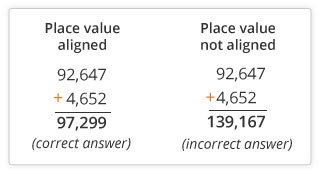
Sample problem 1: Addition with multi-digit numbers
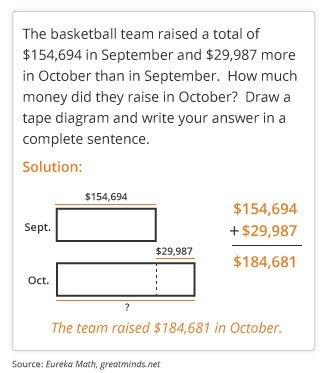
Sample problem 2: Multiplication with multi-digit numbers
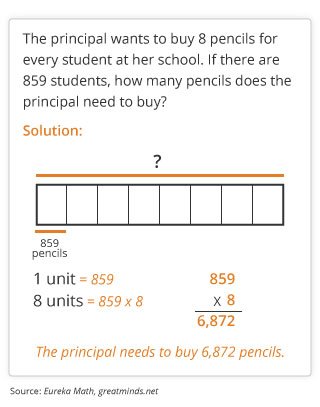
Sample problem 3: Division with multi-digit numbers
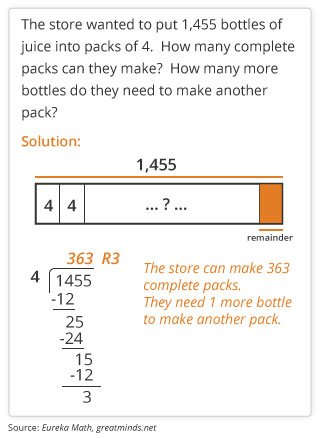
In fourth grade, students learn to add and subtract fractions with the same denominator (bottom number) and to multiply a fraction by a whole number.
Watch fourth graders doing word problems that involve fractions.

Sample problem 4: Adding and subtracting fractions
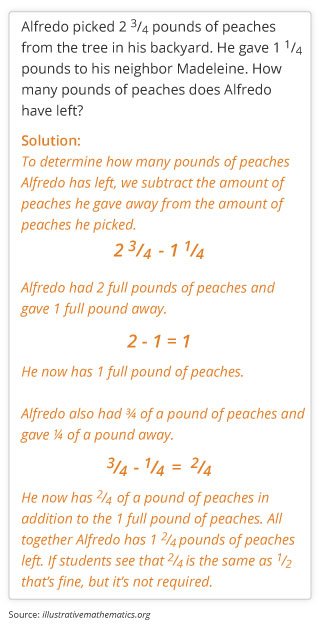
Fourth graders also need to be able to multiply a fraction by a whole number.
Sample problem 5: Multiplying a fraction by a whole number

Students learn to work with fractions with different denominators (the bottom number) and numerators (the top number). They also need to be able to explain why two fractions with different denominators can have the same value (also known as equivalent fractions).
Sample problem 6: Finding equivalent fractions
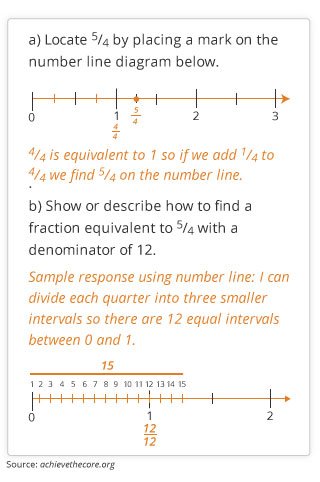
Students are also asked to compare fractions by creating visual fraction models or finding common denominators or numerators (bottom number and top number).
Sample problem 7: Comparing fractions
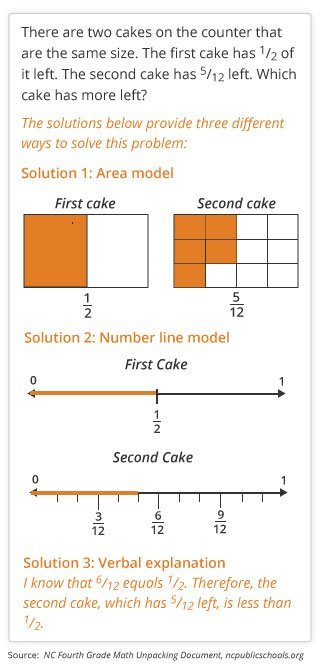
In fourth grade, students learn to write fractions with a denominator of 10 or 100 in decimal notation. They often learn to do this by decomposing numbers using what they known about place value. For example, to convert 12 34⁄100 to 12.34, kids learn to break the number down to 10 + 2 + 3⁄10 + 4⁄100 and then the fractions are converted to decimals, so it’s 10 + 2 + 0.3 + 0.04.
Sample problem 8: Decimal notation for fractions
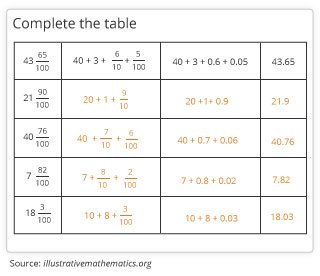
Attitude is contagious; so make sure yours is positive when talking to your child about math. There’s actually research showing that kids with “math-anxious” parents learn less than their classmates and become more anxious about math themselves.
Ask your child’s teacher what specific math skills your child is struggling with and how you can help. Tell the teacher about activities outside of school that your child enjoys and ask if there’s a way to work math into those activities.

Honestly, Additional and Supporting Content sounds a little like “feel free to ignore,” so we asked the experts to explain. This content is given less weight on the PARCC test. These skills support the Major Content for fourth grade and should help set your child up for success in future grades.
Fourth graders gain a new understanding of whole numbers by learning that they are the products of factors. For example, the number 6 has two factor pairs: 6 x 1 and 2 x 3; the number 42 has four factor pairs: 1 x 42, 2 x 21, 3 x 14, and 6 x 7. Learning about factors supports the major skills of doing multi-digit multiplication and division and finding equivalent fractions.
Fourth graders develop a stronger understanding of fractions and equivalent fractions (knowing that 4⁄8 is equivalent to 1⁄2, for example) by learning to place them on number a line.
For example, say students are asked to place the fractions 2⁄8, 3⁄4, and 1⁄2 on a number line. First, students will have to find the lowest common denominator (here it’s 4), find the equivalent fractions with the new common denominator (here it’s 1⁄4, 3⁄4, and 2⁄4), and then figure out where to place them correctly on the number line.
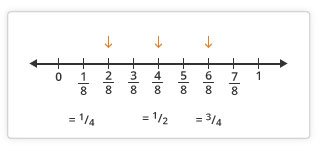
By the end of fourth grade, students are expected to fluently use all four operations (+, -, x, ÷) to solve two-step word problems involving perimeter and area of a shape, even if the length of one side is unknown. For example, the perimeter of this quadrilateral is 16 feet. If side A = 5 feet, side B = 2 feet, and side C = 6 feet, then how long is side D? First, students need to add the three known sides: 5 + 2 + 6 = 13. Second, they need to subtract 13 from 16 to find the length of side D: 3 feet.
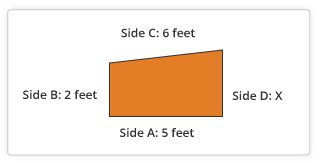
Students also learn about angles, including how to measure them, how they’re classified (for example, a right angle = 90°), and how to draw them using a protractor. Fourth graders learn how to connect angles to fractions because each degree of an angle is 1⁄360 of a 360 degree circle.
Attitude is infectious. Having a positive attitude about math will rub off on your child and it’ll show in many positive ways. But beware: so will a negative attitude, so try to keep your math talk positive.
You’re the expert on your child, but the teacher is the expert on how kids learn. Take advantage of the teacher’s knowledge by meeting to ask for tips and resources from the expert on how to help your child at home.

When students explain and defend their work, they can’t simply say, “I just know that it’s right!” Fourth graders need to be able to explain their work and defend their answers using words, charts, graphs, diagrams, drawings, and equations to illustrate the steps they took.
Students should be able to recognize when their reasoning has gone astray and explain the flaws in their logic. They also may be asked to (nicely) critique their classmates’ work.
Note: If slowing down and re-reading doesn’t help your child, talk to the teacher about getting your child some extra help. (You may also want to read more about the signs of a reading issue.)
Students are now asked to understand how math works and why. If kids have only been taught how to solve a problem using a certain procedure, they may be stumped when faced with a problem that doesn’t give them that step-by-step information. Fourth graders should be able to talk through their thinking and explain why something is true using words or pictures.
Sample problem 1: Explaining reasoning
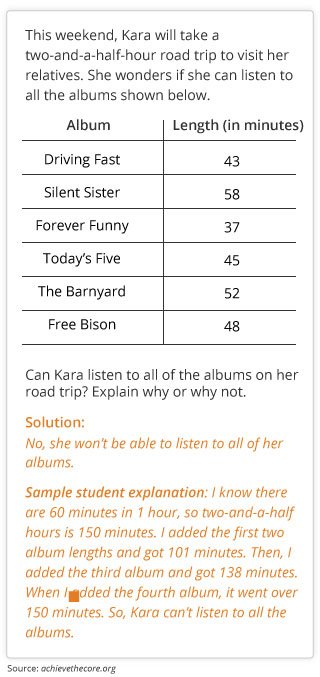
Teachers might use a question like the next one to figure out which students fully understand the concepts in a problem. To answer this question correctly, students need to know that 1⁄2 represents part of a whole and that half of something large is not equal to half of something small.
Sample problem 2: Critiquing the reasoning of others
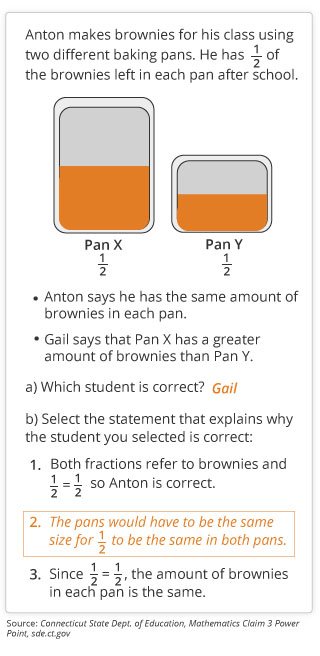
Research shows that confidence matters when it comes to math. When kids see themselves as capable at math, it boosts their willingness to stick with difficult problems. On the other hand, it’s not useful for kids to consider themselves “brilliant.” Overconfidence leads kids to shy away from difficult problems. How can you help? Make sure your child hears from you that she can learn math and be good at it, but it may take some effort.
Email is fine for a simple question, but if you want to have a conversation with your child’s teacher, arrange a face-to-face meeting. Explain to the teacher beforehand that you’d like to see copies of your child’s work to understand where she’s having difficulty. This way, the teacher will have time to put the materials together and spend some time thinking about your child’s needs before you meet.

We all know it’s important for kids to master basic procedures such as multiplication and division. But math is more than memorizing facts or even procedures. Math boosts an essential skill: problem solving. Kids learn problem solving when the path to solving the problem isn’t clear. To do this, kids need to learn skills that include modeling and data analysis.
Sound complicated? Actually, we do it every day. Modeling and application means taking a real-world problem and using math to solve it — with a graph, an equation, a table, or a drawing. For example, a problem like If you want to devote 1⁄3 of a 20-by-30 foot backyard to a vegetable garden, how many square feet would it need to be? could be solved using an equation or by drawing the backyard to scale and dividing it into three equal rectangles. This would be an example of using modeling to solve a real-world problem.
Fourth graders learn how to apply the math they know to solve problems in everyday life and to make sense of problems and persevere in solving them. The test questions designed to measure these skills require students to be able to identify the important information in problems and figure out which steps to take and what tools to use (examples: pictures, graph paper, ruler) to find the answer. The following problem tests whether students can break down a multi-step problem and use pictures or equations involving multiplication to solve it.
Sample problem 1: Solving real-life, multi-step problems
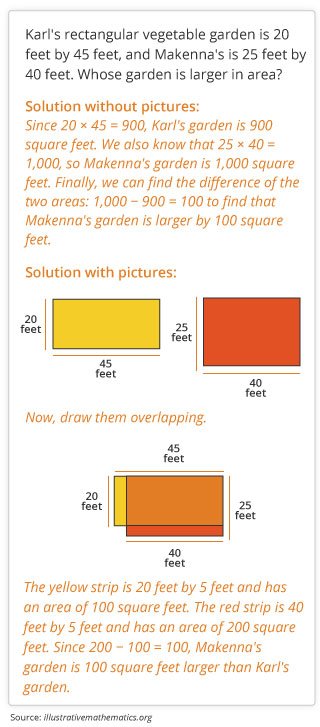
The problem below asks students to make sense of the data in the chart and use it to find the answer.
Sample problem 2: Analyzing and using data from a chart
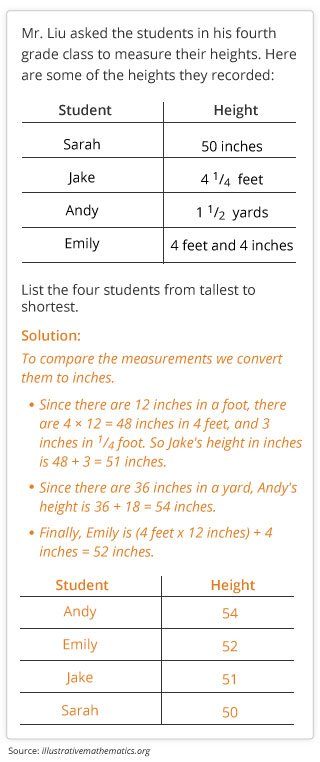
Be enthusiastic about your child being a great problem solver! Emphasize how great problem-solving skills will allow your child to do more cool things on her own. Does she enjoy building things? Is she trying to raise money to buy something? Isn’t it nice when she can figure things out without your help? The more kids see the practical side of math, the more exciting it becomes.
Ask your child’s teacher how you can help your child identify flaws in mathematical reasoning. Find out what questions you could ask your child to get him to focus on places where he tends to make mistakes. Ask the teacher to point out examples in your child’s work where he struggled with a concept so you’ll have a better understanding of how to help.

GreatKids created this guide to help you understand your child's state test scores and to support your child's learning all year long. We worked with PARCC and leading teachers in every grade to break down what your child needs to know and exactly how you can help